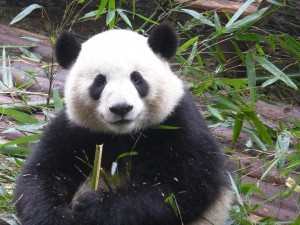
Oreo is a 1-year-old male panda. At this age, he’s about 27 kilos and too large to hold. For the photo, I can only sit next to the cub and awkwardly try to put my arm around him. As the last in line for the photo op, he doesn’t seem to mind if I muffle his fur while I give him an odd sort of hug. After the 20 or so people in front of me, Oreo has begun to ignore the attention, concentrating on his honey-covered bamboo stick. As the Chinese caretakers usher us all through the line, snapping the photo and urging us along, I have crossed one more item off my bucket list.
Touring the Chengdu Panda Reserve

Upon arriving at the Chengdu Research Base of Giant Panda Breeding, our tour guide snaps a photo of Chris and me posing in front of the panda-shaped entrance way. We have both paid about 60 RMB (about 10 USD) to enter the park plus another 100 RMB (about 16 USD) for an English-speaking guide.
We walk through about a half mile of natural habitat, bamboo forests, seeing roughly 40 pandas. Our guide tells us it’s good we’ve come in the early morning since the pandas will be more active at this time. As the bears are best suited for the cold, they are more active in the cool dawn hours. She warns we must move quickly before midday approaches, bringing warmer temperature that the pandas begin to conserve their energy in and fall asleep.
In all of China, there are only about 1,600 giant pandas. Due to an over-hunting of the animal in ancient times, the panda is now considered an endangered species.Collected for their unique color pattern, pandas were presented as gifts to emperors during early dynasties and other countries, such as Japan, as political offerings. The US received its first panda, Su Lin, in 1934 at the San Diego Zoo. This practice stopped in 1983, and pandas are now only given internationally on loan programs.
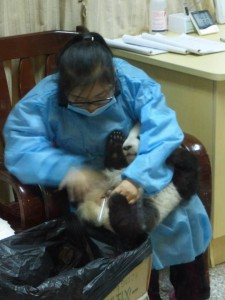
To help conserve the country’s national animal, the CRBGPB was established in 1987. Located in the heart of Sichuan province, one of only three provinces in all of China where the panda is a natural inhabitant, Chengdu with its cris-crossing mountain ranges is in the middle of the native panda habitat and is the only location in the world that is home to wild and captive pandas.Today, the CRBGPB has more than 100 pandas.
In the first section, we see the 2-year-old pandas who have recently separated for the first time from their mothers. They are frolicking and climbing on and through the platforms provided by the reserve. As pandas are typically solitary creatures who become aggressive when trespassers come into their territories, these early friendships will not last.
Farther along, we see the full-grown pandas, 5 years old and above. These bears are more lethargic. Many are lounging while they eat bamboo sticks while others are fast asleep. As they need approximately 70 kilos of bamboo a day to stay healthy, they don’t do much more than eat, drink plenty of water to digest the fibrous plant, defecate every two hours, and sleep up to 14 hours a day. To help hold the bamboo in place and feed themselves, pandas have six digits on each paw. At each enclosure there are plaques providing the name, age, sex, family line and birth date of the bears. We see Xiao, Jingjing, Yuanrun and other traditionally-named pandas basking in the sun.
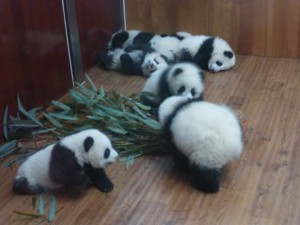
Next up is the breeding, birthing and baby care center. With mating season in the spring, births typically take place in the fall and winter. At birth, newborns are pitiful pink whimpering things who don’t even open their eyes until about 40 days old and only weigh about 100 grams. The black and white fur starts to appear at about 2 weeks old. Though we don’t see any newborns, there are 3-months-olds that are so cute it makes me want to reach through their glass enclosure and squeeze them.
Usually only one cub is birthed to a mother at a time, but sometimes twins are born. In the wild, a mother will only pick one of the cubs to raise, leaving the other to die. At the reserve, though, many mothers encounter false pregnancies or miscarriages. When this happens, a twin cub is given to her to raise.

As we exit the center, we arrive in the exhibit of red pandas. The tour guide tells us the reserve actually brought in the red pandas only after they were made popular by the movie Kung Fu Panda. These cousins to the giant pandas, red pandas resemble racoons more than their black and white family members. They race up trees instead of the slower climbing gait of their cousins, and they eat much less than their black-and-white kin.
At the end of the tour, we take a walk through the small museum on the reserve with panda artifacts, photos, videos and lessons. Of course, the musuem exit is through a gift shop where you can purchase all sorts of panda memorabilia, such as stuffed animals, jewelery, books and post cards.
Panda photo op
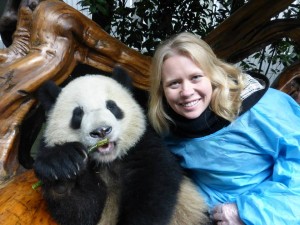
After a generous “donation” of 2,000 RMB (about 325 USD), I am ushered into a small room with about 20 other people where we watch a video about the development of giant pandas. After the video, the guide gives a speech about pandas, showing us an incubator where newborns are kept, holding up a model of one.
The group is then escorted to another building where we adorn surgical frocks, shoe coverings and plastic gloves. We enter into another room of the building where Oreo sits on a bench and we line up for our three-minute photo op. As the guide ushers us through the line, two other assistants keep Oreo entertained by handing him stick after stick of bamboo dipped in honey. As the 1-year-old panda greedily snatches for another treat, members of the group sit beside Oreo as the photographer snaps the official photo and their friends click photos on their phones. If you sit too long, the guide will insist you move along.
A young guy tries to take a bamboo stick from Oreo for a photo, and the staff is quick to shout and perform the “Chinese windshield wiper” in his face. He settles back more appropriately for his photo and then is ushered out. Once we all have a chance to take our photo, we exit into another room where we remove all our surgical garb, and Oreo is led back to his mother in the nursery area.
We wait for the photos to be developed, and then we receive a gift bag. Inside, there is an official certificate thanking us for the “donation,” a panda pin and scarf, and our photo in a glass frame. Though I look a bit funny in the picture, I can now say I’ve met and touched a live panda.
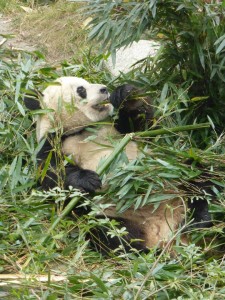
Supporting the Chengdu Panda Reserve
I highly recommend visiting the Chengdu Panda Reserve for an up close and personal look at these unique black-and-white bears. Certainly go for the English guide, but the photo op is completely up to how important the experience is to you. On one hand, I certainly got to do something I’ve always dreamed of, and I was supporting a great cause. On the other, just know you’ll be really rushed and there isn’t much interaction for what you pay.
What is on your bucket list?
-Monica
